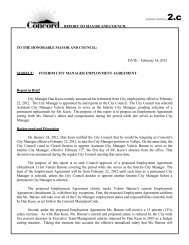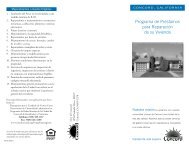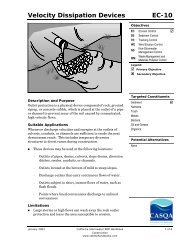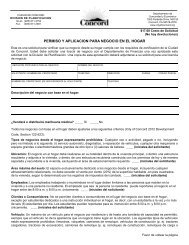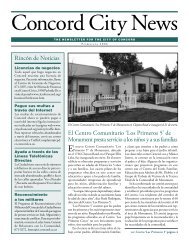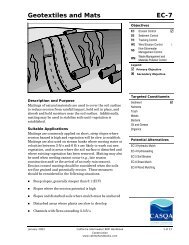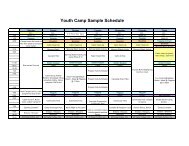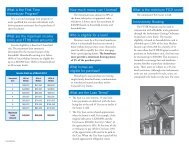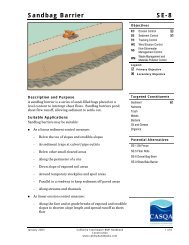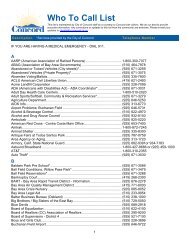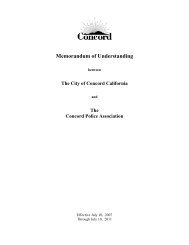Liquid Waste Management WM-10 - (BMP) Handbooks
Liquid Waste Management WM-10 - (BMP) Handbooks
Liquid Waste Management WM-10 - (BMP) Handbooks
You also want an ePaper? Increase the reach of your titles
YUMPU automatically turns print PDFs into web optimized ePapers that Google loves.
<strong>Liquid</strong> <strong>Waste</strong> <strong>Management</strong><strong>WM</strong>-<strong>10</strong>ObjectivesECSETCWENS<strong>WM</strong>Erosion ControlSediment ControlTracking ControlWind Erosion ControlNon-Stormwater<strong>Management</strong> Control<strong>Waste</strong> <strong>Management</strong> andMaterials Pollution ControlLegend: Primary Objective Secondary ObjectiveDescription and Purpose<strong>Liquid</strong> waste management includes procedures and practices toprevent discharge of pollutants to the storm drain system or towatercourses as a result of the creation, collection, and disposalof non-hazardous liquid wastes.Suitable Applications<strong>Liquid</strong> waste management is applicable to construction projectsthat generate any of the following non-hazardous by-products,residuals, or wastes:• Drilling slurries and drilling fluidsTargeted ConstituentsSedimentNutrientsTrashMetalsBacteriaOil and GreaseOrganicsPotential AlternativesNone• Grease-free and oil-free wastewater and rinse water• Dredgings• Other non-stormwater liquid discharges not permitted byseparate permitsLimitations• Disposal of some liquid wastes may be subject to specificlaws and regulations or to requirements of other permitssecured for the construction project (e.g., NPDES permits,Army Corps permits, Coastal Commission permits, etc.).• <strong>Liquid</strong> waste management does not apply to dewateringoperations (NS-2 Dewatering Operations), solid wastemanagement (<strong>WM</strong>-5, Solid <strong>Waste</strong> <strong>Management</strong>), hazardousJanuary 2003 California Stormwater <strong>BMP</strong> Handbook 1 of 4Constructionwww.cabmphandbooks.com
<strong>WM</strong>-<strong>10</strong><strong>Liquid</strong> <strong>Waste</strong> <strong>Management</strong>wastes (<strong>WM</strong>-6, Hazardous <strong>Waste</strong> <strong>Management</strong>), or concrete slurry residue (<strong>WM</strong>-8, Concrete<strong>Waste</strong> <strong>Management</strong>).• Typical permitted non-stormwater discharges can include: water line flushing; landscapeirrigation; diverted stream flows; rising ground waters; uncontaminated pumped groundwater; discharges from potable water sources; foundation drains; irrigation water; springs;water from crawl space pumps; footing drains; lawn watering; flows from riparian habitatsand wetlands; and discharges or flows from emergency fire fighting activities.ImplementationGeneral Practices• Instruct employees and subcontractors how to safely differentiate between non-hazardousliquid waste and potential or known hazardous liquid waste.• Instruct employees, subcontractors, and suppliers that it is unacceptable for any liquid wasteto enter any storm drainage device, waterway, or receiving water.• Educate employees and subcontractors on liquid waste generating activities and liquid wastestorage and disposal procedures.• Hold regular meetings to discuss and reinforce disposal procedures (incorporate into regularsafety meetings).• Verify which non-stormwater discharges are permitted by the statewide NPDES permit;different regions might have different requirements not outlined in this permit.• Apply NS-8, Vehicle and Equipment Cleaning for managing wash water and rinse waterfrom vehicle and equipment cleaning operations.Containing <strong>Liquid</strong> <strong>Waste</strong>s• Drilling residue and drilling fluids should not be allowed to enter storm drains andwatercourses and should be disposed of.• If an appropriate location is available, drilling residue and drilling fluids that are exemptunder Title 23, CCR § 2511(g) may be dried by infiltration and evaporation in a containmentfacility constructed in conformance with the provisions concerning the Temporary ConcreteWashout Facilities detailed in <strong>WM</strong>-8, Concrete <strong>Waste</strong> <strong>Management</strong>.• <strong>Liquid</strong> wastes generated as part of an operational procedure, such as water-laden dredgedmaterial and drilling mud, should be contained and not allowed to flow into drainagechannels or receiving waters prior to treatment.• <strong>Liquid</strong> wastes should be contained in a controlled area such as a holding pit, sediment basin,roll-off bin, or portable tank.• Containment devices must be structurally sound and leak free.• Containment devices must be of sufficient quantity or volume to completely contain theliquid wastes generated.2 of 4 California Stormwater <strong>BMP</strong> Handbook January 2003Constructionwww.cabmphandbooks.com
<strong>Liquid</strong> <strong>Waste</strong> <strong>Management</strong><strong>WM</strong>-<strong>10</strong>• Precautions should be taken to avoid spills or accidental releases of contained liquid wastes.Apply the education measures and spill response procedures outlined in <strong>WM</strong>-4, SpillPrevention and Control.• Containment areas or devices should not be located where accidental release of thecontained liquid can threaten health or safety or discharge to water bodies, channels, orstorm drains.Capturing <strong>Liquid</strong> <strong>Waste</strong>s• Capture all liquid wastes that have the potential to affect the storm drainage system (such aswash water and rinse water from cleaning walls or pavement), before they run off a surface.• Do not allow liquid wastes to flow or discharge uncontrolled. Use temporary dikes or bermsto intercept flows and direct them to a containment area or device for capture.• Use a sediment trap (SE-3, Sediment Trap) for capturing and treating sediment laden liquidwaste or capture in a containment device and allow sediment to settle.Disposing of <strong>Liquid</strong> <strong>Waste</strong>s• A typical method to handle liquid waste is to dewater the contained liquid waste, usingprocedures such as described in NS-2, Dewatering Operations, and SE-2, Sediment Basin,and dispose of resulting solids per <strong>WM</strong>-5, Solid <strong>Waste</strong> <strong>Management</strong>.• Methods of disposal for some liquid wastes may be prescribed in Water Quality Reports,NPDES permits, Environmental Impact Reports, 401 or 404 permits, and local agencydischarge permits, etc. Review the SWPPP to see if disposal methods are identified.• <strong>Liquid</strong> wastes, such as from dredged material, may require testing and certification whetherit is hazardous or not before a disposal method can be determined.• For disposal of hazardous waste, see <strong>WM</strong>-6, Hazardous <strong>Waste</strong> <strong>Management</strong>.• If necessary, further treat liquid wastes prior to disposal. Treatment may include, though isnot limited to, sedimentation, filtration, and chemical neutralization.CostsPrevention costs for liquid waste management are minimal. Costs increase if cleanup or finesare involved.Inspection and Maintenance• Inspect and verify that activity–based <strong>BMP</strong>s are in place prior to the commencement ofassociated activities. While activities associated with the <strong>BMP</strong> are under way, inspect weeklyduring the rainy season and of two-week intervals in the non-rainy season to verifycontinued <strong>BMP</strong> implementation.• Inspect <strong>BMP</strong>s subject to non-stormwater discharge daily while non-stormwater dischargesoccur.January 2003 California Stormwater <strong>BMP</strong> Handbook 3 of 4Constructionwww.cabmphandbooks.com
<strong>WM</strong>-<strong>10</strong><strong>Liquid</strong> <strong>Waste</strong> <strong>Management</strong>• Remove deposited solids in containment areas and capturing devices as needed and at thecompletion of the task. Dispose of any solids as described in <strong>WM</strong>-5, Solid <strong>Waste</strong><strong>Management</strong>.• Inspect containment areas and capturing devices and repair as needed.ReferencesStormwater Quality <strong>Handbooks</strong> - Construction Site Best <strong>Management</strong> Practices (<strong>BMP</strong>s) Manual,State of California Department of Transportation (Caltrans), November 2000.4 of 4 California Stormwater <strong>BMP</strong> Handbook January 2003Constructionwww.cabmphandbooks.com



